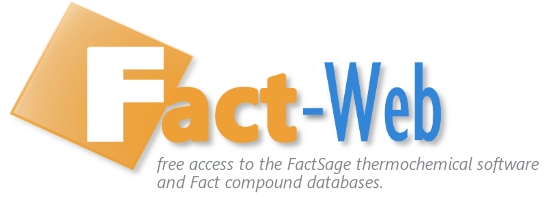|
||||||||||

FactSage:
To cite FactSage in a publication, please use the following:
C. W. Bale, E. Bélisle, P. Chartrand, S. A. Decterov, G. Eriksson, A.E. Gheribi, K. Hack, I. H. Jung, Y. B. Kang, J. Melançon, A. D. Pelton, S. Petersen, C. Robelin. J. Sangster and M-A. Van Ende, FactSage Thermochemical Software and Databases, 2010-2016, Calphad, vol. 54, pp 35-53, 2016 <www.factsage.com>
Fact-Web:
If you employ the results of Fact-Web calculations in a publication make sure that you are aware of the limitations of the calculation. This is particularly important in Equilib-Web which does not have access to real solution data.
To cite Fact-Web or one of its modules in a publication please use the following reference:
C. W. Bale and E. Bélisle, Fact-Web suite of interactive programs, www.factsage.com
To cite FactSage in a publication, please use the following:
C. W. Bale, E. Bélisle, P. Chartrand, S. A. Decterov, G. Eriksson, A.E. Gheribi, K. Hack, I. H. Jung, Y. B. Kang, J. Melançon, A. D. Pelton, S. Petersen, C. Robelin. J. Sangster and M-A. Van Ende, FactSage Thermochemical Software and Databases, 2010-2016, Calphad, vol. 54, pp 35-53, 2016 <www.factsage.com>
Fact-Web:
If you employ the results of Fact-Web calculations in a publication make sure that you are aware of the limitations of the calculation. This is particularly important in Equilib-Web which does not have access to real solution data.
To cite Fact-Web or one of its modules in a publication please use the following reference:
C. W. Bale and E. Bélisle, Fact-Web suite of interactive programs, www.factsage.com
